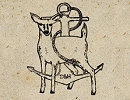Contact Seller
Doe And Hope
Tel07729 213013Please quote Antiques Atlas.


 Pair of Antique Continental Porcelain Figures
Pair of Antique Continental Porcelain Figures
 Spectacular Pair of Large Antique Moorish Figures
Spectacular Pair of Large Antique Moorish Figures
 Pair of spelter figures of Warriors
Pair of spelter figures of Warriors
 Highly decorative early 20thc Chinese Buddha
Highly decorative early 20thc Chinese Buddha
 Vintage Whistling Boy Figure, English
Vintage Whistling Boy Figure, English
 Pair Indonesian Wall Plaques
Pair Indonesian Wall Plaques
 Large Weeping Buddha
Large Weeping Buddha
 Pair of Pottery Black Forest Huntsmen Figures
Pair of Pottery Black Forest Huntsmen Figures
 Large 20th Century Artist's Dummy or Mannequin
Large 20th Century Artist's Dummy or Mannequin
 Art Deco Lady lighter - Lorenzl (attr)
Art Deco Lady lighter - Lorenzl (attr)
 Large Carved Thai/Burmese Buddha Statue,c1880
Large Carved Thai/Burmese Buddha Statue,c1880
 Large Joan of Arc Jeanne d'arc Statue Signed
Large Joan of Arc Jeanne d'arc Statue Signed
Non UK callers :
+44 7729 213013
English Pine Artist’s Lay Figure by Roberson & Co.


The late nineteenth century English pine artist's lay figure, having articulated pivoted ball joints allowing for a natural bending and turning the arms and legs, with pencil inscriptions to the reverse and the partially discernible ink stamp for Roberson & Co Ltd, the whole with a good patina and surviving from the late Victorian period.
The figure remains very decorative and essentially sound considering he is so versatile and would have been moved into thousands of different positions over decades of use. Each ball joint moves freely.
Roberson & Co, artist's suppliers of 51 Long Acre London, exhibited at the Great Exhibition in 1851, their catalogue boasting a wide range of products including Parisian lay figures. An artist would have probably rented this mannequin from them as they were very expensive.
At the exhibition their catalogue featured a wide range of products, including Parisian lay figures (Price List of Materials for Drawing and Painting, 68pp, bound into the Official Descriptive and Illustrated Catalogue of the Great Exhibition 1851, vol.16, copy in V&A National Art Library, EX.1851.135). The company had a wide-ranging reputation which extended to certain specific areas. It specialised in supplying lay figures to artists, 1840s to 1920s, using various subcontractors. The Roberson archive includes a number of life-size lay figures (Woodcock 1998). For a detailed and well illustrated survey, see Sally Woodcock, ‘The Life of a London Lay Figure: Charles Roberson, a Case Study’, in Jane Munro, Silent Partners: Artist and Mannequin from Function to Fetish, 2014, pp.62-71.
The articulated human figure made of wax or wood has been a common tool in artistic practice since the 16th century. Its mobile limbs enable the artist to study anatomical proportion, fix a pose at will, and perfect the depiction of drapery and clothing. Over the course of the 19th century, the mannequin gradually emerged from the studio to become the artist's subject, at first humorously, then in more complicated ways, playing on the unnerving psychological presence of a figure that was realistic, yet unreal--lifelike, yet lifeless.
Mannequins, also known a lay-figures, became more androgynous from the 18th into the 19th century, by which time they were constructed in pine, linden or walnut with wooden pegs and separate male and female figures were seldom made. Reaching their peak of manufacture and popularity in France circa 1850, ownership was coveted. "Mannequin Articule" would be listed in the inventory of important artists' possessions at that time.
The pursuit of the perfect form starts here.
SellerDoe And Hope
View all stock from
Doe And Hope

 Private dealer, By appointment only
Private dealer, By appointment only
The Onion Barn, Shoe Cottage,
15 High Street, Blunham,
Bedfordshire, MK44 3NL.
MK44 3NL
Tel : 07729 213013
Non UK callers : +44 7729 213013
Get directions to Doe And Hope
The figure remains very decorative and essentially sound considering he is so versatile and would have been moved into thousands of different positions over decades of use. Each ball joint moves freely.
Roberson & Co, artist's suppliers of 51 Long Acre London, exhibited at the Great Exhibition in 1851, their catalogue boasting a wide range of products including Parisian lay figures. An artist would have probably rented this mannequin from them as they were very expensive.
At the exhibition their catalogue featured a wide range of products, including Parisian lay figures (Price List of Materials for Drawing and Painting, 68pp, bound into the Official Descriptive and Illustrated Catalogue of the Great Exhibition 1851, vol.16, copy in V&A National Art Library, EX.1851.135). The company had a wide-ranging reputation which extended to certain specific areas. It specialised in supplying lay figures to artists, 1840s to 1920s, using various subcontractors. The Roberson archive includes a number of life-size lay figures (Woodcock 1998). For a detailed and well illustrated survey, see Sally Woodcock, ‘The Life of a London Lay Figure: Charles Roberson, a Case Study’, in Jane Munro, Silent Partners: Artist and Mannequin from Function to Fetish, 2014, pp.62-71.
The articulated human figure made of wax or wood has been a common tool in artistic practice since the 16th century. Its mobile limbs enable the artist to study anatomical proportion, fix a pose at will, and perfect the depiction of drapery and clothing. Over the course of the 19th century, the mannequin gradually emerged from the studio to become the artist's subject, at first humorously, then in more complicated ways, playing on the unnerving psychological presence of a figure that was realistic, yet unreal--lifelike, yet lifeless.
Mannequins, also known a lay-figures, became more androgynous from the 18th into the 19th century, by which time they were constructed in pine, linden or walnut with wooden pegs and separate male and female figures were seldom made. Reaching their peak of manufacture and popularity in France circa 1850, ownership was coveted. "Mannequin Articule" would be listed in the inventory of important artists' possessions at that time.
The pursuit of the perfect form starts here.
Price The price has been listed in British Pounds.
Conversion rates as of 29/APR/2024. Euro & Dollar prices will vary and should only be used as a guide.
Always confirm final price with dealer. Phone or visit the website to buy, Free UK shipping.
Date c.1890
Late 19th Century Antiques Material Pine
Origin English
Item code as155a1856 / 1925
Status Sold
£2400.00 
$3011.52 
€2811.12 

$

€

Conversion rates as of 29/APR/2024. Euro & Dollar prices will vary and should only be used as a guide.
Always confirm final price with dealer. Phone or visit the website to buy, Free UK shipping.
View all stock from
Doe And Hope

 Private dealer, By appointment only
Private dealer, By appointment onlyThe Onion Barn, Shoe Cottage,
15 High Street, Blunham,
Bedfordshire, MK44 3NL.
MK44 3NL
Tel : 07729 213013
Non UK callers : +44 7729 213013
Get directions to Doe And Hope
You may also be interested in
 Pair of Antique Continental Porcelain Figures
Pair of Antique Continental Porcelain Figures
 Spectacular Pair of Large Antique Moorish Figures
Spectacular Pair of Large Antique Moorish Figures
 Pair of spelter figures of Warriors
Pair of spelter figures of Warriors
 Highly decorative early 20thc Chinese Buddha
Highly decorative early 20thc Chinese Buddha
 Vintage Whistling Boy Figure, English
Vintage Whistling Boy Figure, English
 Pair Indonesian Wall Plaques
Pair Indonesian Wall Plaques
 Large Weeping Buddha
Large Weeping Buddha
 Pair of Pottery Black Forest Huntsmen Figures
Pair of Pottery Black Forest Huntsmen Figures
 Large 20th Century Artist's Dummy or Mannequin
Large 20th Century Artist's Dummy or Mannequin
 Art Deco Lady lighter - Lorenzl (attr)
Art Deco Lady lighter - Lorenzl (attr)
 Large Carved Thai/Burmese Buddha Statue,c1880
Large Carved Thai/Burmese Buddha Statue,c1880
 Large Joan of Arc Jeanne d'arc Statue Signed
Large Joan of Arc Jeanne d'arc Statue Signed







